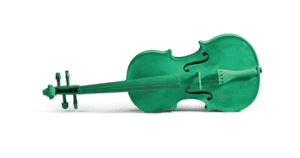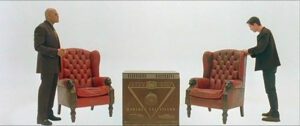Pablo Halguera

A few years back, when I still worked in a museum, I was at a meeting with a prominent chief curator, someone who, while cordial, seldom smiled and generally displayed a rigorously dry, intellectual, seemingly unbreakable stolid demeanor proper to his institutional status.
We were discussing a panel discussion that we would put together in conjunction with a show he was curating. A curatorial assistant had drafted a list of possible speakers, but all the names in the list were the usual suspects. Aside from being all-white and on the older side. I asked whether we could diversify the list of speakers a bit, and also maybe include someone from a new generation. The curator agreed and suggested that an emerging scholar named So Young Kim could be a good addition to the panel. ‘Because,’ he said, and then paused for a moment she is… So Young’ Then he started laughing uncontrollably. We laughed too, but his laughter attack, verging on tears, made him almost fall off the table and continued for a while even after we all regained composure and attempted to resume the meeting.
This, I think, was an institutional museum version of what in theater is called corpsing: uncontrollable laughter that an actor or a broadcaster might have while on stage or live TV. The term comes from British theater, referring to an actor who might be playing a corpse and would suddenly break character by laughing. There are many examples online about incidents where news anchors hopelessly struggle to get through a segment but delirious laughter completely takes over. The pressure created by an environment where the stakes are very high (thousands if not millions of viewers) paradoxically makes it harder for the presenter to regain control, and more often than not the laughter becomes contagious amongst others in the set.
I am writing this as I am about to go onstage to present my first off-Broadway show, a stand-up comedy act, one that specifically takes the art world as a subject. As part of the process of putting it together I had to reflect on matters of humor in contemporary art, and in particular the question of which are the systemic platforms that cause the kind of tension that, when poked at, can result in a spectacular deflation and the curatorial corpsing I witnessed at that meeting. Partially it has to do, I believe, with the psychology of the white cube and its construction as an essentially unemotional space.
In encyclopedic museums, it is interesting to pay attention to the design decisions that mark the transition between the 19th and 20th century galleries; the latter which would typically are all-white in contrast to other wings of the building. The whiteness of the galleries, as well as the usual bathing in generous natural light, would give the subliminal impression that the 20th century is more enlightened era of art history. But the prevailing feeling of the white cube was one of cryptic formality, one that could feel intimidating, especially given that the works one would see would be radical departures from traditional aesthetics: conceptual art, installation, and video.
When I think of the first experiences I had with these spaces, as a teenager, the feelings that I draw from those memories are ones of puzzlement and fascination, but also of attraction to the uncanny. Even the objects that appeared to contain humor (in particular Pop Art, like the Claes Oldenburg sculptures of oversized everyday objects and the Roy Lichtenstein paintings after comic strips) caused in me such puzzlement that I would feel more unsettled than amused.
This instinctive feeling I had as a teenager, and which I could not have articulated then, in fact connects very directly with the actual experiences of regular, non- art experts when they visit a contemporary art museum. I explored this dynamic when I was a young educator at the Museum of Contemporary Art in Chicago, when we started surveying people’s responses to the exhibitions and placed a comment form to get their feedback. I distinctly remember a comment from a visitor who wrote that while visiting the collection galleries she had encountered a work that made her laugh out loud; and almost immediately felt embarrassed by her own reaction. She wanted to know if she had done something inappropriate.
This is not unusual. But the question that interests me is not so much why a regular museum visitor would find the white cube to be a sort of alien space governed by rules akin to the ones of a secret society; nor am I too interested in the criticisms of the white cube model (of which I have written in the past). Rather, I am more interested in the social and cultural conditions that made the white cube come into being in the first place. The aspiration, attainable or not, of a completely neutral context eventually made its way to Hollywood by the end of the 20th century, in the postmodernist science-fiction film The Matrix (by the way quite a humorless movie), when the captain Morpheus guides the main character, Neo, through a computer program called The Construct. I share the dialogue the two characters have which ends in the famous phrase later borrowed by Slavoj Zizek:
‘Morpheus: This is the construct. It’s our loading program. We can load anything from clothing, to equipment, weapons, training simulations, anything we need.
Neo: Right now we’re inside a computer program?
Morpheus: Is it really so hard to believe? Your clothes are different. The plugs in your arms and head are gone. Your hair is changed. Your appearance now is what we call residual self-image. It is the mental projection of your digital self.

©Warner Bros
Neo: This…this isn’t real?
Morpheus: What is real. How do you define real? If you’re talking about what you can feel, what you can smell, what you can taste and see, then real is simply electrical signals interpreted by your brain. This is the world that you know. The world as it was at the end of the twentieth century. It exists now only as part of a neural-interactive simulation that we call the Matrix. You’ve been living in a dream world, Neo. This is the world as it exists today … Welcome to the Desert of the Real.’
If you really think about it, The Construct is nothing but a version of the white cube: a loading program that redefines what is real, that constructs a fiction that displaces reality (as a museum educator I personally love Morpheus inquiry-based learning style reply to Neo’s question of whether something is real: How do you define real? If you’re talking about what you can feel, what you can smell, what you can taste and see – similar to what trained educators reply when a visitor asks if something is art).
In particular – and this is not to question any other contextual and historical aspects around the invention of this modernist exhibition model – I am interested in how as these types of spaces (be it the white cube or the construct) attempts to present a blank slate where there is theoretically no memory, no historical connections, and no human context, seeks to implicitly enshrine and defend the importance of contemporary art, functioning not just as an empty space but an inheritor of the mausoleum tradition handed down by the classical museum construct and, in the process, nip in the bud any novice’s opinion that contemporary art is a joke. For that to happen, the strict, pristine, unemotional austerity of the white cube whether in commercial galleries or museums, marks a rupture with the everyday world. And that rupture as a result, inhibits spontaneous forms of human expression, just as medieval churches were constructed with the specific goal to communicate awe, devotion and respect. So laughter in those circumstances naturally feels out of place.
And precisely because of the standard staid, stiff and repressed environment that forms the legacy of the white cube there is a long tradition of institutional critique work that makes fun of it through humor, from Broodthaers through Andrea Fraser and up to and including Maurizio Cattelan, and beyond. For Fluxus artists, the intentional absurdity of many of its compositions was effective because it mimicked the bourgeois solemnity of the classical music concert and bourgeois culture in general, of which the traditional art museum is part of. Equally interesting is, however, how long it took museums to appreciate what Fluxus artists were doing – for the longest time, curators in institutions like MoMA that were so steeped into formalism in the 60s and 70s largely saw those artists as wild and crazy and their work something that was ‘not for us’. They only figured out their mistake 40 years later. I confess, as an artist that often traffics in humor, that I am dependent of the boring, academic white cube as a counterpoint to do my work, so I am grateful to their continued existence.
But given that continued existence, the puzzlement if uninformed museum visitors continues, of course, which, seen from the insider angle, is not without its own humor.
As part of another education department initiative at the MCA, led by my then supervisor and mentor Wendy Woon, we worked with other museum staff to construct an automated booth where visitors would be invited to press a button that would activate a video camera and then could record their comments about a particular work on view (the first one was Tony Cragg’s Red Bottle from 1982). The initiative was titled Talk Back. But being as it was the mid 1990s, video equipment not that advanced and our team not being experts in interactive technologies, the analog hookup system had quite a number of flaws; sometimes people would leave the camera running and we would end up with hours and hours of video of an empty booth; sometimes people would just be confused as to what to do inside; other times people would use the camera to expose themselves or do sub-par performances. But we did get a few gems every now and then: most memorable was a middle-aged man who seemed genuinely confounded by contemporary art but dutifully tried to share his thoughts as prompted by the instructions. After a long and rambling series of comments trying to figure out the meaning of the work and acknowledging that he was an art novice, he concluded in the form of an awkward greeting: “I really have no idea what this is, but if this thing is art… my name is Bob.”
